Menu
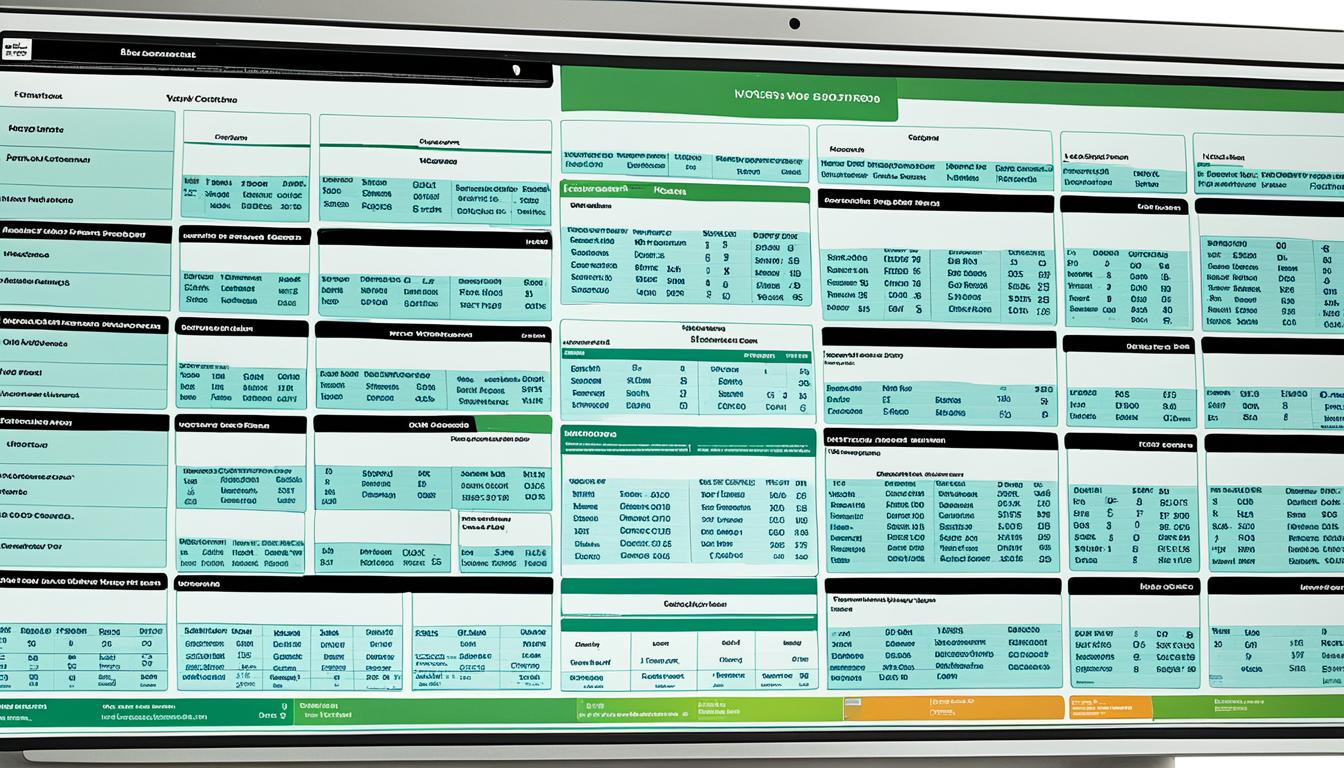
Almost 6 million cattle have been certified thanks to the Progressive Beef quality assurance program. This highlights the growing need for accurate, efficient, and traceable systems in our field. Yet, many organisations still rely on paper methods. These can lead to mistakes and are not very efficient. Moving to digital livestock records can greatly improve how we track herds and manage farms.
Our cutting-edge software is made for the livestock and farming sector. It allows for easy management of tasks, access to data in one place, and quick solutions to quality issues. This shift makes it possible to track products all the way from the farm to the consumer. Plus, it gives farmers powerful data analysis tools. This helps them boost productivity and efficiency like never before.
New technology helps save money by making daily operations more efficient. When things go digital, teamwork improves. This is great for engaging employees. By moving tasks like assignments and tracking to digital platforms, companies can avoid the problems of using paper. This includes making sure they meet all regulations and having more accurate data.
Digital data management doesn’t just lower the risk of recalls. It also makes audits simpler by storing all data in one place. Then, advanced analytics help benchmark and improve how well we do across different sites. This way, the whole industry can benefit from using digital methods for tasks, managing data, and tracking products.
Digital livestock records are changing how farms are managed. They make farming blend old ways with new technology. This change is making farm work more efficient through better data handling.
These records cover animal data and farm finances. With these tools, farmers can keep close track of their livestock. This technology helps in identifying animals, tracking their health, and managing breeding plans.
Moving from paper to online records is big for farms. Old ways were slow and could have mistakes. Using digital tools, farmers can be more accurate and save time.
Along with precision, digital records let farmers use big data. This means they can make decisions based on trends.
Companies like AgriWebb are helping farmers go digital. They offer special software. This software has helped over 11,500 livestock farmers worldwide. Their teams in Australia, the UK, and the US help farmers succeed with these tools.
The move to digital livestock records brings many benefits. It changes the way we run farms. It makes managing herds easier and helps farms be more sustainable.
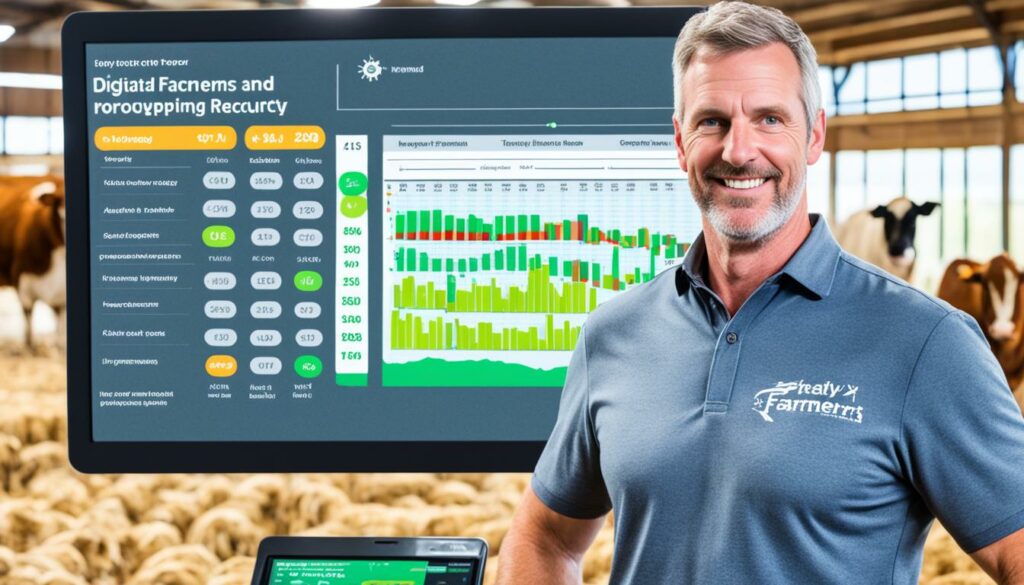
Using digital records helps us handle data better. We can look at all kinds of information about our animals. This means we make smarter choices and know our animals well.
Most farmers who tried digital records say their farms are more efficient. On the other hand, using paper slows things down. It makes running farms harder.
With digital tools, quick and smart decisions are easier. They help manage tasks and check animal health in time. This makes the animals healthier.
Getting the needed information is 5 times faster with digital records. This speeds up how we react to problems. As a result, more farmers saw their crops do better thanks to digital smarts.
Digital tools also help the environment. They help us use resources better so we can graze our animals more wisely. This is good for the land and the animals.
Many farmers say using digital tools makes their farms more eco-friendly. They become better at preventing diseases. This means less impact on the environment and safer food for us.
Digital livestock records help us be more organised and keep our data secure. Farmers everywhere are using these new technologies to run their farms better. They help animals stay healthy and farms work in ways that are good for the planet.
In today’s agriculture, livestock management software is crucial. It helps farms be more efficient, integrating many tasks into one system. This makes farming more modern than ever before.
Livestock software shines in its ability to handle daily jobs without human interference. This change is key for workflow optimisation, moving away from traditional paper methods. It takes care of tracking events, setting feeds, and medical needs. This eases the workload for farmers. It also tracks tasks in real time and picks up if any are missed, keeping everything on track.
| Feature | Benefit |
|---|---|
| Event Tracking | Eliminates manual record-keeping |
| Feeding Schedules | Optimises nutritional balance |
| Medical Care | Ensures precise and timely management |
| Auto-Reassignment | Prevents task omission |
This software collects all data in one place, making record-keeping easier. It holds all data, from animal details to how they perform. This makes meeting rules simpler and improves overall farm tracing. Using this tech, farmers keep up with the latest, using their resources more wisely. By keeping everything in one place, this technology helps with breeding, feed, and keeping animals healthy. It also makes farms safer from risks by using real-time data for smart decision-making.
To sum up, using livestock management software makes farming better. It meets the needs of today’s agriculture. This tech makes managing herds a must-have for farms, not just a choice.
Modern farm practices have seen a big change with the use of online farm records. This move has made farm operations much more efficient. By keeping data updated in real-time, farmers can make decisions with the most current and accurate information. Plus, they can check these records from anywhere, changing how we work with livestock and manage resources.
Now, with digital systems, managing cattle records has become easier. This includes details on the cattle’s identities, health, breeding, and money matters. Real-time updates have made a big difference. They make sure farmers deal with important matters quickly, leading to better herd health and breeding results. Machines don’t make mistakes, so these digital records are always correct, which helps the farm run smoother.
One top advantage of online farm records is being able to check data from anywhere. This has made our work a lot more flexible and efficient. It means farmers can respond to problems right away, making the farm run better. Using the latest tech, like smart sensors and automatic feeding, we’re improving how we look after our herds. This means better performance from our livestock and more profit.
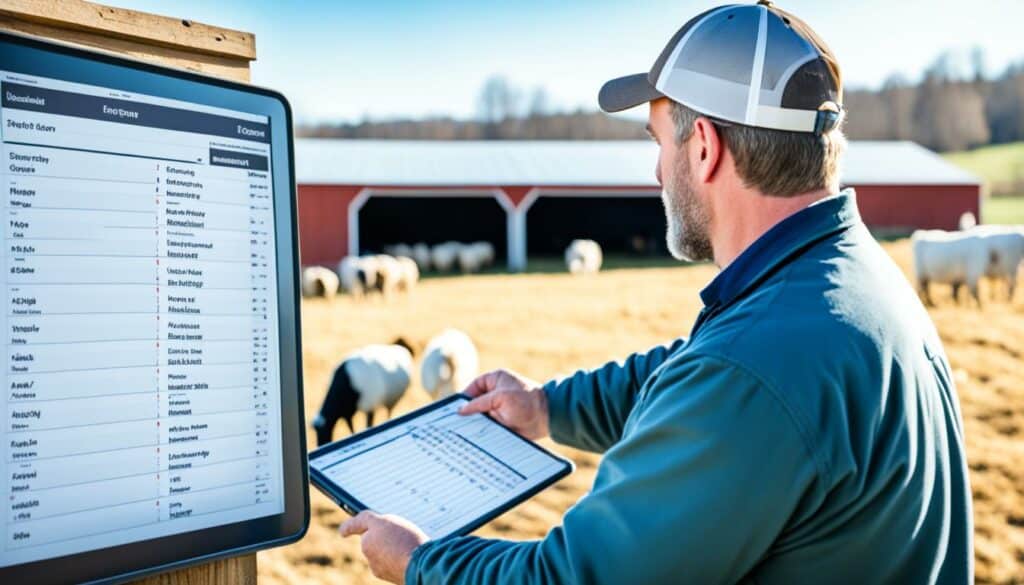
Technological advancements in agriculture are making us re-think how we manage farms. Going digital in farming helps protect the environment by using resources better and creating less waste. These new digital systems are excellent for keeping careful and up-to-date records on livestock. This helps make smart choices that are good for the farm’s health and money-making.
Electronic animal records are key in today’s herd management. They use advanced tech, like RFID tags with unique numbers. This tech ensures precise tracking and management. It leads to better traceability and care of animals.
Keeping accurate animal health records is vital for livestock well-being. Digital systems track health and vaccinations closely. This allows quick spotting of health trends. It helps in stopping diseases before they spread.
Now, EID records are a must in the industry. They help track animals better and meet export standards. They bring more transparency from farm to food.
Good genetic tracking helps improve livestock quality through breeding. Animal records offer info on breeding, genes, and lineage. This helps farmers choose animals wisely. It boosts breeding efficiency.
PastureMap supports EID records, making decisions better. Japan recognizes EID-verified beef, showing the value of good genetic records.
| Program | Benefit |
|---|---|
| Progressive Beef | Certified nearly 6 million cattle for food safety and sustainability. |
| GAP 5-Step Program | Adopted by retailers for transparency and higher beef production standards. |
| Japan’s EID Program | Pays premiums for source and age-verified beef. |
The growing use of herd management software shows the value of digital tools. These tools boost efficiency and livestock quality. With them, the future of managing livestock is digital.
Precision farming is now the norm in livestock, boosting productivity. It uses digital solutions to make farming more efficient. This ensures we always have the latest real-time data.

Livestock farms are using data analytics for better productivity. Software tools help analyse lots of data from various sources on the farm. This lets farmers track livestock well-being and the health of pastures easily. With this info, they can make right decisions, improving outcomes.
New tech, like mobile near-infrared devices, checks feed quality instantly. This gives farmers quick nutritional details out in the field. Also, advanced tools for pigs spot breathing issues early, improving care. Such tools show how analytics boosts farming.
Using predictive farming is key to better livestock health. With animal trackers, farmers collect health data for early disease spotting. There’s also new tech, like milk sensors, for tracking animal health and production.
Then, there’s tech to check animals’ body compositions via apps, for better maintenance planning. These tools, with data management, help monitor performance goals and make proactive choices.
The livestock sector is going digital quickly. For example, some dairy farms now use robots for tasks. This ‘connected cow’ trend highlights the value of data for effective livestock care and productivity.
| Feature | Benefit |
|---|---|
| Mobile Near-Infrared Devices | Real-time feed quality monitoring |
| Sound Diagnostic Tools | Early detection of respiratory issues in swine |
| RFID Animal Trackers | Detailed data on herd health and welfare improvement |
Overall, using big data and predictive methods in farming takes a proactive stance. This boosts not just productivity but also animal health and welfare.
Thinking about digital livestock records implementation? It’s important to check if your farm is ready for this change. Look at your farm’s setup, web connection, and how you manage data. These things need to be solid so they support modern herd management well.
A digital herd management system boosts your farm’s accuracy and precision. Farms need to keep exact cattle records to avoid big mistakes. Digital systems remove problems like bad handwriting. They make records reliable because they cut out human errors.
Going digital also cuts down on hard paperwork. This saves time, letting farmers work on keeping their herds healthy and their farms sustainable. It also helps them make better choices with the right data.
Using digital records means keeping track of health, breeding, money matters, and the environment. It works better when it’s linked with other digital tools like smart sensors and GPS. These add more power and efficiency to the whole system.
Being able to use it all on the go is a big plus for farmers. It means they can check things and decide while they’re in the fields. Also, having a good backup plan for your data is key. It keeps your records safe and reliable over time.
Digital transformation in livestock management can lead to increased productivity by optimising employee engagement through collaborative digital environments.
Getting into modern herd management with digital tools needs a good plan. Choosing software that fits your farm is crucial. This makes the switch to digital records easy. It boosts how well you can use and trust your data.
With the right decisions and digital support, farmers can improve the health and profit of their herds. This means more sustainable and efficient farming.
Modern livestock management needs good inventory systems. They help farmers track and monitor animals in real-time. Livestock management software makes it easy to manage records, finances, and analyse data.
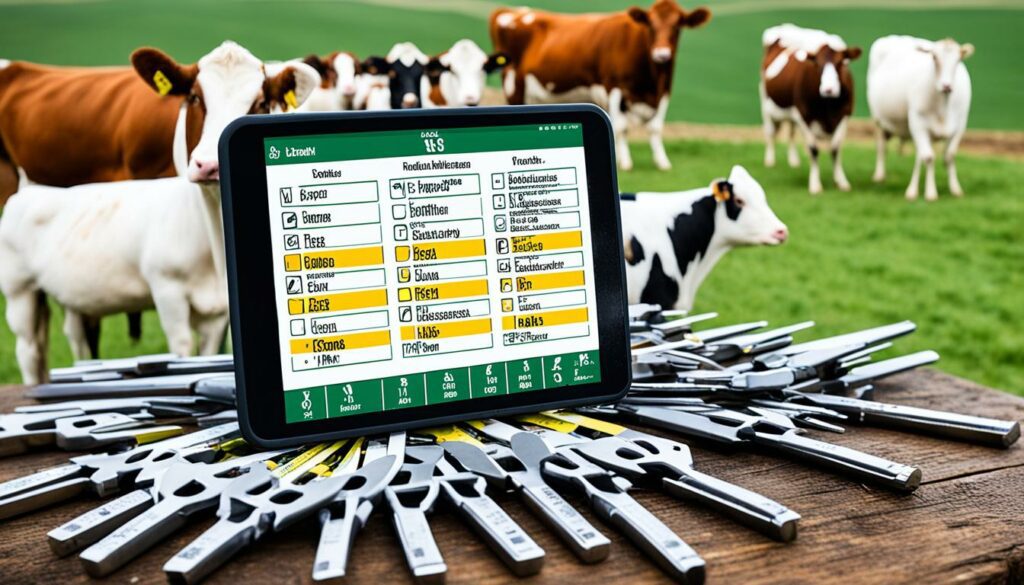
With the help of EID systems from companies like #Allflex Livestock Intelligence and #Gallagher Livestock Manager, each animal gets a unique ID number. This makes tracking their health, movement, and data very accurate. It helps manage stock well by keeping inventory records current.
Keeping good records is key for a farm’s transparency. Tools like #Farmbrite and #CattleMax let farmers look at data to make smart decisions. They can spot patterns in animals’ performance. This data can help with managing herd health, growth, and more.
Mobile apps such as #Livestocked and #PigVision Mobile give ranchers access to some inventory tools on their phones. This means they can check on their animals from anywhere. Systems like #HerdDogg and #Moocall use sensors to watch over things like temperature and animal behaviour.
Adding genetic tools from companies like #zoetis#CLARIFIDE and #Neogen#GeneSeek can improve animal genes. This focuses on traits that matter like growth and disease resistance. All these tools work together to make livestock management better.
In the 21st century, meat producers and processors must be very efficient. They must stand strong during the digital revolution. A livestock tracking app uses GPS and RFID to manage cattle over large areas.
The blend of GPS tracking and RFID in apps has changed livestock management. It tracks animals accurately from the farm to the consumer. Automating this process lowers mistakes and non-compliance, thus boosting efficiency and accuracy.
A livestock tracking app gives alerts and updates on animals’ locations and health. This helps herders act fast, avoiding health problems or losses. The app’s data tools also monitor performance well, helping in quick, smart decisions for better livestock management.
These tech advances ensure better efficiency, transparency, and security for herds. They lead to improved livestock operations and performance.
Starting to use digital records for livestock can be hard. Important problems include keeping data safe and teaching people how to handle digital records.
In today’s world, using high-tech farming and data analysis is key. But, keeping our farming data safe is very important. When we move from paper to digital ways, there are new dangers like hacking. It’s vital to pick software that guards our information well. This makes sure our data is safe and helps people trust us more.
Switching to digitised records means everything is in one easy-to-check place. This makes it great for inspections and tracking where our products come from. In the food supply industry, having good records is important for safety. Progressive Beef, for example, makes sure 6 million cows meet high quality and safety standards. They do this by handling data well.
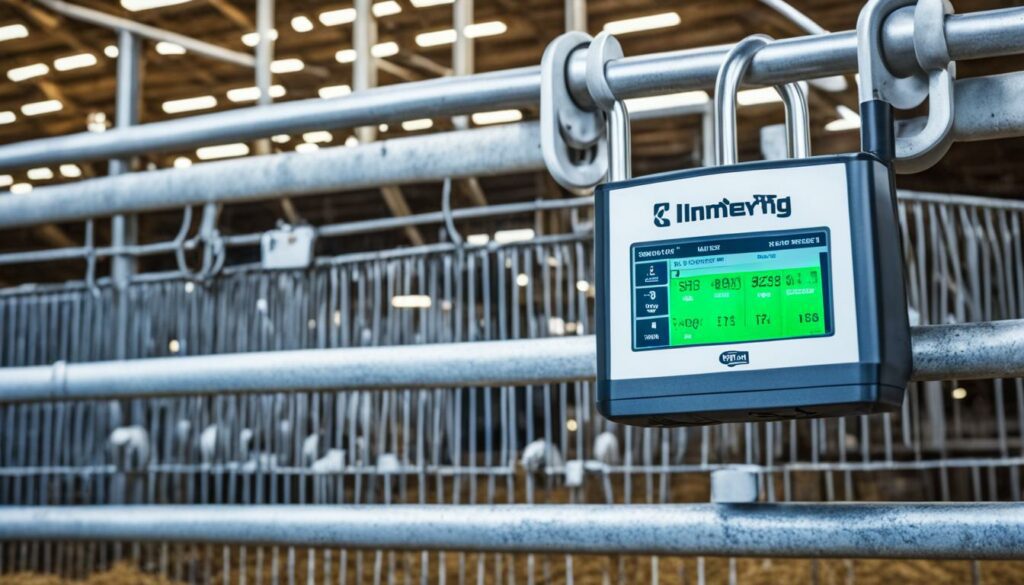
Moving from paper to digital records is a big change. It helps a lot, cutting down on mistakes and making work more precise. Still, lots of places stick to traditional, time-wasting ways. This can make things slower and prone to errors.
One way to tackle this is through proper training. Farm staff should know how to use new digital tools. This makes the change smoother and work more efficiently. Good training means everyone knows how to use the new systems well.
Using technology for task management also helps. It makes assigning and tracking jobs faster and more accurate. This reduces mistakes and keeps everything running smoothly.
In the end, we need to handle data security and adoption challenges carefully. Good training and strong security measures are key. They help make the most of digital tools. They can change how we manage farms for the better, boosting productivity.
When it comes to digital livestock record keeping, looking at the costs is key. A detailed cost-benefit check shows the money you’ll spend at first. This includes technology and the tools producers need. But the pay-off is in the long term, with better choices, more efficient work, and more money made.
At the start, the cost of the tech needed for digital records might scare you off. You’ll need to buy things like RFID tags and scanners, plus HerdView® software. And everyone on the farm needs to know how to use it. But, these costs pay off over time. They cut down on the hard work needed and make fewer mistakes.
Yes, it costs a lot to begin with, but you’ll save a bunch and get more productive work done. Keeping records digitally means you use your farm’s resources better. And you can keep the animals healthier. This makes more money for you. Also, you’re more likely to meet the world’s standards for keeping livestock. And it shows your buyers they can count on you. This edge helps you sell more. So, putting money into this technology is good for business in the long run.
| Investment Aspect | Details | Recent Findings |
|---|---|---|
| Initial Hardware and Software | RFID scanners, HerdView® software | Estimated positive ENPVs and minimal risk of falling below a 12% discount rate |
| Training and Adoption | Personnel training on digital tools | CIAT’s annual training for 15-20 East African participants highlights growing adoption rates |
| Long-Term Savings | Improved efficiency, reduced manual labour | Improved decision-making, productivity, and profitability as endorsed by various World Bank and FAO reports |
In the world of farming today, going digital is a game-changer. A great example is Progressive Beef. It jumped headfirst into using digital tech to make its work smoother. This case study looks at how they moved from pen-and-paper to hi-tech digital livestock records.

By going digital, Progressive Beef could track their work in real time. This was a big step up for them. They used smart sensors and gadgets in their everyday work, like in the milking parlours. This cut out a lot of mistakes because it meant less manual data entry.
Switching to digital also meant putting all their data in one place. This made it easy to check they were following the rules. With this setup, they could quickly pass any checks that came their way. That meant they had more time to focus on their main jobs and not worry about the paperwork.
These digital changes aren’t just happening here. Countries known for their advanced farming, like Denmark and Sweden, are doing similar things. Yes, there was a big cost to start with. But Progressive Beef’s story shows it’s worth it. Their move to digital tools has made their work more efficient and accurate.
This case study from Progressive Beef clearly shows the upsides of using digital tech on the farm. They turned to digital livestock records and up-to-the-minute work tracking. And besides helping them work better, it’s key to their long term goals of staying ahead and caring for the land.
The move to digital livestock records is changing farming. It marries old ways with new tech. This shift boosts how we manage, care for animals, and in looking after our land. By using digital tools, we make work smoother. This means fewer mistakes and wasted efforts compared to using paper.
Farmers raising animals for meat need to use technology well to stay strong. They can get special safety and green stamps for their beef. This makes sure that problems are addressed fast, avoiding big product recalls. It also helps during checks by making papers easy to find.
Using digital tools also makes it easier to keep and find data. This means we can track food all the way from the farm to you. It helps everyone work better together, making their jobs more interesting. Smart use of data also helps farmers know more about their animals. They can feed them better and handle breeding more wisely. This all adds up to making more money and looking after the land for the future.
Digital livestock records keep all important info on animals in an electronic form. This info includes things like who the animal is, their health details, and their breeding facts. It covers their financial transactions too. You can manage all this online using special farm and animal software.
The change from writing everything down to using electronic records means a big upgrade. It does away with the need for lots of paper. This shift makes keeping records easier, more accurate, and lets people keep track more quickly.
Digital records store all info in one place, making it easy to find everything. This way, all health and management details are together. It makes managing animals better because decisions are based on all the right information.
Having digital data means you get important alerts and clear reports. These help make quick, smart choices. It stops the need for paper calendars and helps run things better. The result is that work is done more wisely and faster.
Using the right software can help in looking after the land better and using fewer resources. It’s good for the planet. It combines smart use of digital records with careful planning to help the environment.
Special software does jobs automatically that previously needed manual work. This includes keeping records up to date and tracking tasks. It cuts out mistakes from paperwork and makes things flow more easily.
Having all the info stored in one place means it’s easy to check whatever you need. This helps match up with rules, trace where things come from, and make choices based on solid facts. It’s key for looking after animals well.
Online records mean you can access and update info at any time from anywhere. Quick, good info helps farmers make the best choices, even when they’re not nearby. It makes managing animals much more efficient.
These records keep track of animal health, who mates with who, and their genes. They show detailed health fixes, when to vaccinate, and how to breed for the best results. This all helps in taking good care of the animals and making them better.
Systems that manage data can forecast when things might need fixing. This helps keep the animals well and make sure they have good pastures to be in. It’s an advanced way to run farms and do the best for the animals.
First, check if your farm is ready for digital ways. Then set up how you’ll keep your data in order. Finally, choose the software that fits your needs best. Doing this right makes running a farm smoother and more effective.
These systems keep a close eye on the animals in real-time and keep accurate records. They help make the farm’s inner workings clear and help farmers do their job well by looking after their animals the best way possible.
Apps with smart GPS and RFID make watching over animals from far away easy. They quickly tell you if something needs your attention. This keeps the animals safe and in good health.
Two big challenges are making sure all data is safe and getting everyone to use the new system well. The answer is to use safe software and teach everyone how to make the most of it. This way, digital farming can be a great success.
The cost up front for new technology can be a lot. But saving time, doing work more efficiently, and making smarter choices in the long run pay off big. It makes farms more competitive and secure for the future.
Progressive Beef swapped paper for digital and found a big improvement. Real-time tracking and automated tasks cut down on mistakes and saved a lot of time. This new way of working meets challenges in livestock farming and makes for a better business.